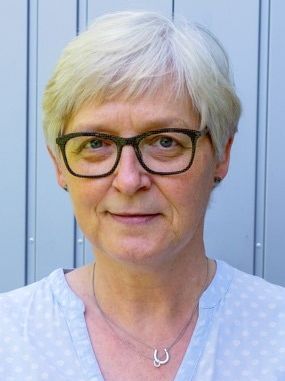
PD Dr. Cora-Ann Schoenenberger
General Information
Department of Chemistry
University of Basel
Mattenstrasse 24a, BPR-1096
4058 Basel, Switzerland
phone: +41 61 207 57 89
email: cora-ann.schoenenberger@clutterunibas.ch
Projects
Life-cell imaging of metabolic processes
Tracing and modifying metabolic pathways in cells
(Collaboration with Prof. V. Vogel, ETHZ)
CV
- PhD in Cell Biology from the University of Basel (production and characterization of monoclonal antibodies against tumor associated glycosphingolipid antigens).
- Postdoctoral research - Ludwig Institute for Cancer, Bern (mammary gland transformation by oncogenes in transgenic mice).
- Postdoctoral SNF fellowships - Harvard Medical School (Boston USA) (effects of oncogenes on epithelial cell polarity).
- Project leader - M.E. Müller Institute/Biozentrum, University of Basel: Designed and established research projects that focus on structural and mechanical aspects of the cytoskeleton, a dynamic network responsible for cell shape and mobility and often altered under pathological conditions such as in cancer. Combining biochemical and molecular biology methods with light microscopy, electron microscopy and atomic force microscopy (AFM) to study cytoskeleton structure and mechanics in health and disease.
2001
Habilitation in Cell Biology, Faculty of Science, University of Basel
since 2013: Senior scientist & lecturer in the the Department Chemistry/University of Basel:
- Cellular applications of microfluidics (Prof. T. Pfohl; to Feb 2016)
- Synthetic polymer vesicles as hulls for artificial cells and organelles (Prof. W. Meier/Prof. C. Palivan; from Feb 2016)
- Biomedical application of bio-inspired nanostructures.
- Modifying cellular functionality by molecular factories and artificial organelles.
other:
- Diploma Secondary School Level II Biology Teacher
- Licensed study director for animal experimentation
Publications (recent)
FAP Targeting of Photosensitizer-Loaded Polymersomes for Increased Light-Activated Cell Killing [link]
M. Skowicki, D. Hürlimann, S. Tarvirdipour, M. Kyropoulou, C.-A. Schoenenberger, S. Gerber-Lemaire, C. G. Palivan
Biomacromolecules2024, DOI: 10.1021/acs.biomac.3c00943
The rise of bio-inspired polymer compartments responding to pathology related signals [link]
L. Zartner, M. S. Muthwill, I. A. Dinu, C. Schoenenberger, C. G. Palivan
J. Mater. Chem. B, 2020, DOI:10.1039/D0TB00475H. Review
A self-assembling amphiphilic peptide nanoparticle for the efficient entrapment of DNA cargoes up to 100 nucleotides in length [link]
S. Tarvirdipour, C.-A. Schoenenberger, Y. Benenson, C. G. Palivan
Soft Matter, 2020, 16, 1678-1691. DOI: 10.1039/C9SM01990A
Battling bacteria with free and surface-immobilized polymeric nanostructures [link]
S. Rigo, M. Kyropoulou, C.A. Schoenenberger, C.G. Palivan in Racing for surfaces, B.Li et al (Editors)
[Publisher Springer Nature Switzerland AG, 2020, DOI: 10.1007/978-3-030-34475-7_17].
Biomolecules turn self-assembling amphiphilic block co-polymer platforms into biomimetic interfaces [link]
S. Yorulmaz Avsar, M. Kyropoulou, S. Di Leone, C.-A. Schönenberger, W. P. Meier, C. G. Palivan
Frontiers in Chemistry, 2019, 6, art. 645. / DOI:10.3389/fchem.2018.00645
Array based real-time measurement of fluid viscosities and mass-densities to monitor biological filament formation.
P. Oliva, B.A. Bircher, C-A. Schoenenberger, T. Braun.Lab Chip, 2019, 19, 1305-1314. DOI: 10.1039/c8lc01343h.
Length scale matters: Real-time elastography versus nanomechanical profiling by atomic force microscopy for the diagnosis of breast lesions [link]
R. Zanetti-Dällenbach, M. Plodinec, P. Oertle, K. Redling, E. C. Obermann, R.Y.H. Lim, C-A. Schoenenberger
BioMed Res Int., 2018, 3840597. DOI: org/10.1155/2018/3840597
Biopores/membrane proteins in synthetic polymer membranes [link]
M. Garni, S. Thamboo, C-A. Schoenenberger, C. G. Palivan.
Biochim Biophys Acta Biomembr., 2017,1859, 619-638. DOI: 10.1016/j.bbamem.2016.10.015. Review.
Actin ADP-ribosylation at threonine148 by photorhabdus luminescens toxin TccC3 induces aggregation of intracellular F-actin.
A.E. Lang, z. Qu, C. Schwan, U. Silvan, A. Unger, C-A. Schoenenberger, K. Aktories, HG Mannherz.
Cell Microbiol.,2017, 19, e12636. DOI: 10.1111/cmi.12636.
Clinical data as an adjunct to ultrasound reduces the false-negative malignancy rate in BI-RADS 3 breast lesions.
S.Ackermann, C-A. Schoenenberger, R. Zanetti-Dällenbach.
Ultrasound Int Open, 2016, 2, E83-9. DOI: 10.1055/s-0042-110657.
Inter- and intra-observer agreement in ultrasound BI-RADS classification and real-time elastography Tsukuba score assessment of breast lesions.
Schwab F, Redling K, Siebert M, Schötzau A, Schoenenberger CA, Zanetti-Dällenbach R.
Ultrasound Med Biol., 2016, 42, 2622-2629. DOI: 10.1016/j.ultrasmedbio.2016.06.017.
Contributions of the lower dimer to supramolecular actin patterning revealed by TIRF microscopy.
U. Silván U, J. Hyotyla, H.G. Mannherz, P. Ringler, S.A. Müller, U. Aebi, T. Maier, C-A. Schoenenberger.
J Struct Biol., 2016, 195,159-166. DOI: 10.1016/j.jsb.2016.05.008.
